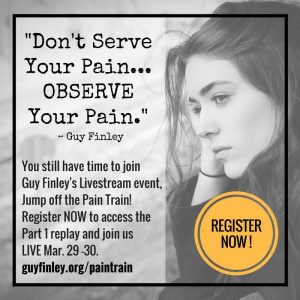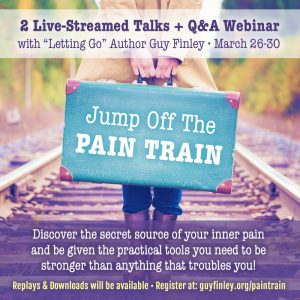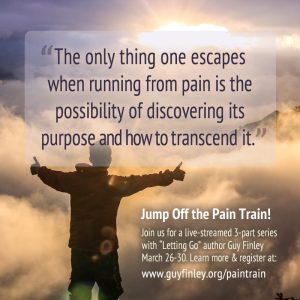If we see how much of our unhappiness is self-created, through being inattentive to our own interior life, then accordingly, we can learn to re-direct our attention, placing it where we will within what is right and bright. But, there is only one way to realize this reversal: we must work to see how wrongly directed attention works against us.
Perhaps a thought pops into your mind about a problem that’s been bothering you. Appearing with it is some emotional disturbance. Now the thought starts rolling, growing in its demand for your attention. Almost instantly it has defined what needs to be done, or what you are powerless to do. And both states accomplish the same dark end: you’ve unknowingly animated that thought and given it a life — and the life you’ve given it is your own! Here’s an example of how this scene might unfold:
A man is walking through his office when his boss walks by and gives him a blank look. The thought pops into the man’s mind that his boss is criticizing him or doesn’t like him. Now, as he starts to fear this idea — a negative picture produced by his imagination — his mind focuses its attention on this disturbing image. And the more he attends to this dark dream, the further into its labyrinth he descends, strengthening its presence and power to further irritate him. A heartbeat later, he has no doubt: the boss has it in for him! This thought grows in authority for him, tormenting him for the rest of the day and causing him to snap at his family when he gets home. And all of this suffering is born of what? The conjunction of a passing glance and a moment of misdirected attention!
Here’s the amazing thing about this illustration, and what we want to learn from it: this whole drama has been played out inside of the man — storyline, stage, cast, and leading characters. But he doesn’t see how this painful state is self-created; instead he believes it has been cast upon him by someone else — his heartless boss! So, what else can he do — being in the dark as he is to his true condition — but try to rid himself of his stressed feelings? How? By arguing with his boss, either outwardly or in his mind. The more he feels punished by the situation that he sees in his mind, the more he wants to fight with it. He’s sure his unwanted experience exists independent of his perception of it, but we can see he’s mistaken. His pain is a product of how he sees the event and then all of the misery that comes with resisting his own mistaken perception. He is quite literally lashing himself, and the more he resists what he thinks is happening, the more it happens to him! This is a good description of what I call the “circle of self.” In it we can see how the pain of our own mistaken perception literally produces the enemies it needs to keep itself alive.
From our vantage point, we can see how his unattended mind first animated a fearful thought, which leads to wrongly feeding it with his own life. We can also see that nothing can change for him until he sees the truth behind his trouble and withdraws his consent from it.
We suffer because we consort with painful thoughts and feelings, thinking somehow that not wanting them makes them “go away.” But our unconscious actions betray us: first, by animating what makes us ache, and then by binding us to that relationship through our resistance to it. Here’s a simple way of saying these last few ideas: not wanting our negative states actually nourishes them! I can almost hear the question that comes next: “Wait a minute! You can’t be saying these dark thoughts and feelings are good, and that we should want what’s hurting us, are you?”
Of course not! Negative states have no right to exist in us as they presently do. And that’s just the point. We literally give them a place to live in our psychic system — feed them, as it were — by trying to rid ourselves of them in the usual ways. But there are other ways of dealing with pervasive dark states besides resisting them, suppressing them, or trying to change the conditions seen as being responsible for them. Instead of these acts of willfulness, we choose in favor of watchfulness. Rather than struggling with dark states, learning to be quietly watchful of them does two things at once: first, it separates us from being wrongly identified with our own thoughts about that troublesome state. In addition — by the light of our newly liberated attention — we catch a glimpse of a powerful insight whose light helps set us free:
If we mistakenly give any negative state its “life” — then the opposite must hold true: we can consciously withdraw that same life any time we so choose!
Here is a simple exercise to help you get started with this new kind of seeing that is the power behind freeing you. Several times each day, whenever you can remember to do it, deliberately disconnect yourself from your own thinking. Choose awareness of your thoughts over being absorbed in the sensations they produce as they carry you along to get what they want. The aim here is simple: reclaim your attention in order to be where you are, and then just quietly notice all that you can about yourself. The light of this new order of awareness empowers you to catch and release what your own unattended thoughts had been busy cooking up for you, using you as stock! Each time you remember to reclaim your attention in this manner, with it you regain your life.
For extra profitable inner practice, learn to see the deception in any assumption that wants you to believe that there is no higher alternative to your suffering than to either run from it or simply endure it. Never listen to any pain that is asking you what to do about it. The moment you seek a solution to its tormented question, you’re under its authority, which makes you its victim.
Look at all of life, and all of its demanding relationships from the undemanding eyes of your higher nature. If you do your part, you can’t help but hit the higher mark. One day the new freedoms you’re sure to see, you will be.


